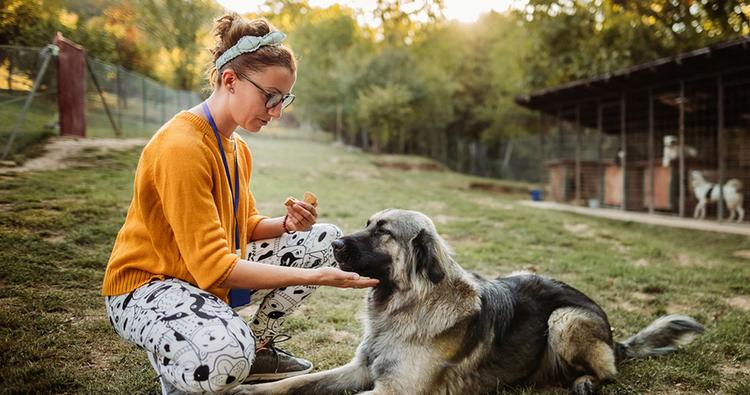How Petting Can Help Shelter Dogs Cope with Stress
This simple act can greatly benefit shelter pups (and humans, too).
This simple act can greatly benefit shelter pups (and humans, too).
by Katie Koschalk, | May 23, 2024

Shelters provide a sanctuary for countless surrendered and stray dogs, offering them safety and care as they wait for a permanent home. Despite the invaluable services shelters provide, the environment can be very stressful for dogs. Even in the most organized shelters, there’s still constant noise, confinement, unfamiliar smells, and limited social contact. All can contribute to an overwhelming experience for their canine residents.
Finding ways to reduce shelter dogs’ stress is essential, and one promising approach is the simple, yet powerful, act of petting. We’ll explain why it helps, but first, let’s discuss why reducing stress in shelter dogs is vital.
Reducing stress in shelter dogs is critical for a few key reasons:
Chronic stress can severely impact a dog’s physical health. Prolonged exposure to stressful conditions can cause, contribute to, or worsen several health issues, including:
A weakened immune system
Colitis
Allergies
Weight loss
Skin issues
Cardiovascular issues
By reducing stress, shelters can help maintain the physical health of the dogs. This makes them more resilient and adoptable.
Stress can lead to anxiety and depression in dogs. Creating a less stressful environment helps prevent mental and emotional decline.
“Stress poses a deadly threat to shelter dogs,” says Kristen Hassen, principal consultant at Outcomes for Pets Consulting. “Most dogs in shelters are confined to kennels 23 hours or more each day, and this level of isolation leads to stress-related behaviors like barking, jumping, and pulling, which makes it harder for the dogs to get adopted.”
In some cases, normally friendly dogs can even start exhibiting aggression. These behaviors not only hinder their chances of adoption but also put them at risk for euthanasia.
To top it off, behavioral issues can make the dogs more difficult for the shelter staff to manage. By reducing stress, shelters can improve the behavior of dogs, making them calmer, more sociable, and ultimately more adoptable.
When shelter dogs (or dogs in any situation) are stressed, you’ll notice some or all of these signs:
Excessive panting
Excessive drooling
Shedding
Tucked tail
Trembling
Yawning
Licking lips
Pacing or restlessness
Excessive whining or barking
Hiding or cowering
Aggression
Loss of appetite
Destructive behavior
Lethargy
Depression
Hypervigilance
Changes in grooming
“Petting shelter dogs should be prioritized as part of a holistic approach of protecting the mental, emotional, and physical well-being of sheltered dogs,” says Hassen. Bonus: Petting dogs has benefits for human petters, too. Let’s explore these benefits in detail.
Petting a dog can offer them the following benefits:
Reduces stress: “Contact with people is one of the most effective ways to reduce anxiety and stress in shelter dogs,” says Hassen. Petting, in particular, helps lower levels of cortisol, the hormone associated with stress. This reduction in cortisol can help alleviate anxiety and create a sense of calm in dogs.
Increases oxytocin levels: Petting stimulates the release of oxytocin, often called the “love hormone.” Oxytocin promotes feelings of happiness, bonding, and well-being.
Reduces blood pressure: By reducing stress levels, regular petting sessions may lower a dog’s blood pressure, which supports a healthier heart.
One big caveat: These benefits only apply to dogs who enjoy being pet. Not all dogs are comfortable with physical touch, especially when they’re scared. So it’s crucial to respect their individual preferences. To ensure petting is beneficial, pay close attention to a dog’s body language. Signs that a dog enjoys being pet include a relaxed posture, wagging tail, and leaning into the touch. Conversely, signs of discomfort include a tucked tail, stiff body, growling, lip licking, or trying to move away.
Interestingly, the benefits of petting dogs extend to the humans doing the petting as well. Studies show that petting a dog for just a few minutes can:
Calm your nervous system
Lower cortisol
Increase oxytocin
Reduce blood pressure
Increase focus
Improves dog behavior: Dogs who are calm, well-behaved, and happy are more appealing to potential adopters. Regular petting sessions help create these positive behaviors, increasing a dog’s chances of finding a permanent home.
Builds trust and sociability: Petting helps dogs build trust in humans, making them more approachable and sociable. This is especially important for dogs who may have experienced neglect or trauma, because it helps open them to forming new relationships.
Enhances adaptability: Reducing stress by petting can improve a dog’s ability to adapt to new environments and experiences. Dogs who are calmer and less anxious are typically better at handling the transition from a shelter to a new home.
Shelter dogs face numerous challenges, but there are many ways you can make a significant difference in their lives.
If you’ve been wondering, “Can I go to an animal shelter to pet dogs?” the answer is yes. In fact, volunteering to spend time with shelter dogs is one of the simplest, most impactful ways to help them. Many shelters welcome volunteers who can pet the dogs, walk them, play with them, and provide much-needed social interaction.
While enriching the lives of shelter dogs through petting, walks, and play is vital, Hassen reminds us that those tactics will only go so far in reducing stress. The best remedy for kennel stress, she says, is getting the dogs out of the shelter environment and into loving homes.
If you’re ready, you could make a difference by adopting a shelter dog. Here are some reasons to consider adoption:
Save a life: Many shelter dogs face euthanasia due to limited space and resources. By adopting, you give a dog a second chance.
Receive unconditional love: Shelter dogs make great pets. They’re often incredibly loyal and loving, forming deep bonds with their human families.
Support ethical practices: Adopting from a shelter combats issues associated with puppy mills and irresponsible breeding.
However, before adopting a dog, you must take an honest inventory of your life to ensure you have enough time, money, living space, and patience to welcome a dog into your home and care for them for several years to come. Also, be mindful that it can take time for a dog to settle into a new home, but there are steps you can take to help a shelter dog adjust.
If you’re not ready for the long-term commitment of adoption, fostering a dog can be an impactful way to help. Fostering a dog entails temporarily caring for a shelter dog in your home while they wait for a permanent home. Here’s how, by fostering, you can make a difference:
Reduce shelter overcrowding: By taking a dog into your home temporarily, you help reduce the number of animals in the shelter, making space for more dogs in need.
Provide individualized care: Fostering allows dogs to receive one-on-one attention and care, helping them develop good habits and become more adoptable.
Learn about the dog: As a foster, you can provide valuable insights into the dog’s behavior, preferences, and needs, which can help match them with the perfect person or family.
Test the waters: Fostering is a great way to see if you’re ready for the responsibilities of caring for a dog without making a permanent commitment. It can be a step towards adoption if you find the right fit.
If you want to help in a more hands-off way, consider donating money, dog food, toys, bedding, and other pet supplies to shelters. Donations are crucial for the operation of shelters and rescues, as they operate on a nonprofit model.
Many shelters struggle with insufficient resources, so finding methods to reduce stress that are effective, yet not too time-consuming and costly, is key. This is why petting is such a good option. Petting a dog for a minute or two several times a day is quick and easy yet has a big impact on the pups.
However, petting is just one component of a holistic approach to reducing stress in shelter dogs. According to Hassen, shelters can further enhance the well-being of their dogs by implementing a variety of strategies, including:
Interactive toys
Training sessions
Walks
Outdoor time
Playgroups
Selective co-housing
Day trip foster outings
Foster overnights
Comfort items, such as blankets, beds, and towels
Positive reinforcement by rewarding desirable behavior with treats
Are you ready to adopt a shelter dog? Use Adopt a Pet’s search feature to find your new family member today.
Chemistry Between People and Dogs Is Real (It’s Science)
Effects of Affiliative Human-Animal Interaction on Dog Salivary and Plasma Oxytocin and Vasopressin
Human Interaction and Cortisol: Can Human Contact Reduce Stress for Shelter Dogs?
Kennel Stress Is a Deadly Threat to Shelter Dogs. The Right Enrichment Can Help Save Them.
Signs Your Dog Is Stressed and How to Relieve It
The Effects of Fear and Anxiety on Health and Lifespan in Pet Dogs

Katie Koschalk is a freelance writer based in Northern California. Fusing her love and knowledge of animals with her journalism degree and years of professional writing, Katie is dedicated to improving the lives of pets and their caretakers by sharing helpful and accurate information. When she’s not at her desk, you can find her exploring trails with her Aussie, Hunter, cooking plant-based meals, and talking to her two cats, Jax and Sadie, in really ridiculous voices.

Breed Info

Shelters & Rescue

Adoption Advice

Behavior & Training
Is your new pup biting everything? Learn effective ways to curb this behavior by teaching bite inhibition.
Behavior & Training

Behavior & Training

Behavior & Training

Behavior & Training

Behavior & Training

Behavior & Training

Behavior & Training

Shelters & Rescue